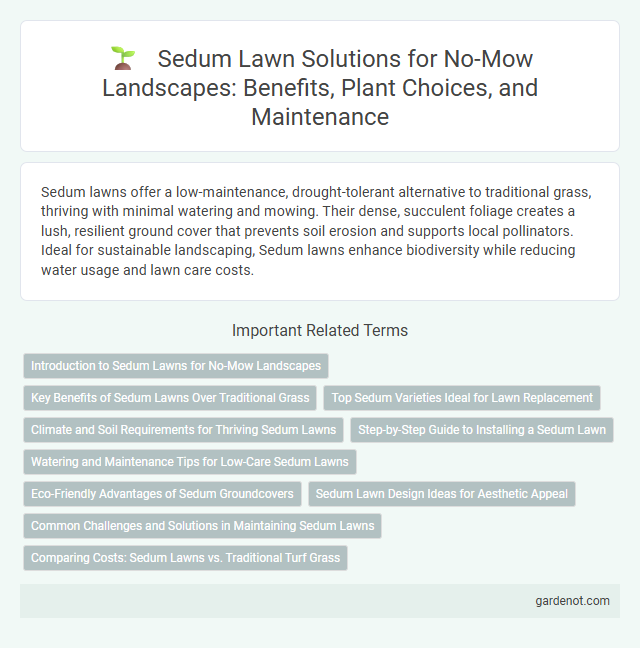Sedum lawns offer a low-maintenance, drought-tolerant alternative to traditional grass, thriving with minimal watering and mowing. Their dense, succulent foliage creates a lush, resilient ground cover that prevents soil erosion and supports local pollinators. Ideal for sustainable landscaping, Sedum lawns enhance biodiversity while reducing water usage and lawn care costs.
Introduction to Sedum Lawns for No-Mow Landscapes
Sedum lawns offer an innovative no-mow landscaping solution characterized by drought-resistant, low-maintenance succulent plants that create lush, green ground cover year-round. These lawns thrive in poor soil conditions and require minimal watering, making them ideal for sustainable, eco-friendly garden designs. Their natural ability to suppress weeds reduces the need for chemical treatments, promoting a healthier outdoor environment.
Key Benefits of Sedum Lawns Over Traditional Grass
Sedum lawns offer significant water conservation benefits compared to traditional grass, reducing irrigation needs by up to 75%. They require minimal mowing and maintenance, cutting down labor and fuel costs associated with lawn upkeep. Sedum's natural drought resistance and pest tolerance promote a healthier, eco-friendly landscape with enhanced biodiversity.
Top Sedum Varieties Ideal for Lawn Replacement
Sedum lawns provide a low-maintenance and drought-resistant alternative to traditional grass, with top varieties like Sedum spurium, Sedum acre, and Sedum album offering excellent ground cover and vibrant color. Sedum spurium thrives in diverse soil conditions and spreads quickly, creating a dense, carpet-like texture ideal for lawn replacement. Sedum acre and Sedum album contribute bright yellow and white flowers respectively, enhancing aesthetic appeal while requiring minimal mowing and supplemental watering.
Climate and Soil Requirements for Thriving Sedum Lawns
Sedum lawns thrive in well-drained, sandy or rocky soils with low fertility, making them ideal for poor soil conditions often unsuitable for traditional turfgrass. These drought-tolerant plants prefer full sun exposure and are highly resilient to heat and dry climates, requiring minimal watering once established. Sedum's adaptability to various soil pH levels, ranging from acidic to alkaline, enhances their suitability for diverse environmental conditions in no-mow lawn applications.
Step-by-Step Guide to Installing a Sedum Lawn
Installing a Sedum lawn begins with preparing the soil by clearing debris, loosening the ground, and improving drainage to create an ideal growing environment. Next, lay Sedum mats or plant Sedum cuttings evenly across the area, ensuring good contact with the soil to promote root establishment. Water the lawn moderately during the initial weeks while avoiding overwatering to support healthy growth and a vibrant, drought-resistant no-mow lawn.
Watering and Maintenance Tips for Low-Care Sedum Lawns
Sedum lawns require minimal watering due to their drought-resistant succulent properties, thriving best with infrequent, deep watering every 2-3 weeks during prolonged dry spells. Maintenance of low-care sedum lawns involves occasional weeding and removing dead foliage to promote healthy growth and prevent fungal diseases. Fertilizing once or twice per year with a balanced, slow-release fertilizer supports vibrant color and resilience without encouraging excessive growth.
Eco-Friendly Advantages of Sedum Groundcovers
Sedum lawns offer significant eco-friendly advantages due to their drought-resistant nature, reducing the need for frequent watering and conserving water resources. Their thick, succulent leaves improve soil health by preventing erosion and promoting microbial activity, fostering a sustainable groundcover option. Sedum groundcovers also enhance biodiversity by providing habitat and nectar for pollinators, supporting local ecosystems while lowering carbon emissions associated with traditional lawn maintenance.
Sedum Lawn Design Ideas for Aesthetic Appeal
Sedum lawn design ideas emphasize low-maintenance, drought-resistant greenery that provides vibrant color and texture year-round. Incorporating varied Sedum species like Sedum album, Sedum spurium, and Sedum reflexum creates visually appealing patterns and natural ground cover that thrives without mowing. Strategic arrangement around pathways, rock gardens, and garden borders enhances aesthetic appeal while promoting eco-friendly landscaping.
Common Challenges and Solutions in Maintaining Sedum Lawns
Sedum lawns often face challenges such as uneven growth, susceptibility to pests like aphids, and watering difficulties that can lead to root rot or drought stress. Solutions include ensuring well-drained soil to prevent waterlogging, selecting drought-tolerant Sedum varieties such as Sedum spurium or Sedum acre, and implementing targeted pest management using natural predators or insecticidal soaps. Regular light trimming helps maintain an even surface and promotes healthy, dense coverage across the lawn.
Comparing Costs: Sedum Lawns vs. Traditional Turf Grass
Sedum lawns typically incur lower maintenance costs compared to traditional turf grass due to reduced watering, mowing, and fertilization needs. Initial installation costs of Sedum, involving succulent plant mats or plugs, may be higher but are offset by long-term savings from minimal upkeep. Over time, Sedum's resilience to drought and pests translates to fewer replacements and less labor, significantly reducing overall lawn care expenses.
Sedum lawn Infographic

 gardenot.com
gardenot.com